Under Bow
Under Bow
The Borough
Under Bow, The Bow or Bow House, took its name from the great timber bow arch which sprang from the edge of the pavement (not to be confused with a small shed-like lean-to attached to the Church House on the corner of Middle Street and Silver Street also referred to as the Bow). Under Bow was an old house, described as 'ancient' and 'typical of many former houses in the town' that stood in the Borough, on the corner of Grope Lane (now Wine Street). It possibly dated to the sixteenth century, if not earlier. It had an overhanging front to the first floor, featuring an oriel window at first floor, supported by two columns. Ruined by fire, it was demolished in the 1860s and caused a stir amongst Yeovilians similar to the destruction of the George in the 1960's.
On Monday, 30 July 1744 the first issue of 'The Western Flying Post, or Yeovil Mercury' was launched in Yeovil by Robert Goadby (d1762), whose hand-printing press was located in the Bow. The newspaper continued to be printed here until 1749 when the proprietor purchased the Sherborne Mercury and moved to Sherborne. Goadby advertised Under Bow on 13 February 1749; "To be Let and Entered upon at Lady-Day next, or before, at an easy Rent, at Yeovil, in the County of Somerset. A very commodious and pleasant Dwellinghouse, with a large Garden and Orchard, Wash House, Barn, Stable, and many other conveniences, wherein the printing-office was lately kept.- Enquire for further particulars of Mr George Cayn of Yeovil aforesaid; of of R Goadby, at the printing office, in Sherborne."
An advertisement in a subsequent issue, the same year, is by John King, who appears to have taken the premises for his own printing office.
As Daniel Vickery put it in his ‘Sketch of the Town of Yeovil’ in 1856 – “At the corner near Wine-street, (Grope Lane), now stands a relic of our former domestic architecture, the venerable old patriarch of bye-gone houses, lending indeed under the weight of timber and of years, but still performing the end of its erection, shelter and use. Ancient domicile!! thou art sadly out of place amid thy flaunting neighbours, and, as is the case sometimes with a poor relation, there are those who would rather have thy room than thy company. Yet we shall part with thee with regret. Thou hast bravely done thy duty to those who have taken shelter, and fought life's battle beneath thy ancient roof, during many generations; but thou hast outlived thy position, and like the Portreeves, thy ancient neighbours, thou must also give place, not to a better, but a more modern and practical dispensation.”
The building was possibly briefly a beerhouse, run by William Baker, during the period 1850 to 1852. This supposition is based on the position of William Baker's entry in the 1851 census, sandwiched between John Tytherleigh's chemist & druggist shop (replaced in 1860 by the Medical Hall) on the other side of Wine Street to the east, and Josiah Hannam's ironmongery to the west.
In 1860 Under Bow was occupied by baker Charles Pyne and his family and the 1861 census recorded him, his wife, four daughters and two sons living there.
Unfortunately, a bakehouse in such a timber structure was probably never a good idea and, in December 1861, a serious fire broke out in the bakehouse, almost completely destroying the building. In its edition of 3 December 1861, the Western Flying Post reported “Serious fire in the Borough – On Sunday evening as the inhabitants of the Borough were proceeding to church, they were alarmed by the appearance of fire issuing from the premises occupied by Mr Pyne, baker etc. In a short time a large concourse of people assembled, the police were soon upon the spot, and it was discovered that the fire had originated in the bakehouse. It made rapid progress and the furniture of two bedrooms was consumed, and that in the other rooms destroyed or rendered of little value by the damage which it received in its hasty removal. The shop goods and fixtures were more or less torn in pieces or destroyed. The town fire engine was first upon the spot, under the direction of Mr Bradley, the West of England engine arriving shortly after. The spectators exerted themselves in a most praiseworthy manner. The fire was put out before it reached the front of the house. The premises are insured in the West of England office for £200. The activity of Mr Bradley and Mr Curtis Jnr was conspicuous.”
Many thanks to Phil Nichols for finding the following report, which is from the 5 December 1861 issue of the Dorset County Chronicle: “Somersetshire – Yeovil …. Fire – On Sunday evening last, at about 6 o’clock, the usual quietude of the Yeovil Sabbath was disturbed by the cry of fire, which rapidly ran through the streets. This arose in consequence of the house in the occupation of Mr Pyne, baker, being in flames. The borough fire engine, under the superintendence of Mr Bradley, and worked by several members of the fire brigade – which has just been formed of the principal tradesmen of the town – very shortly arrived, and with a ready supply of water from the neighbouring houses, and willing hands for conveying the same, it quickly proved itself the master of the flames, but not until the house, as well as furniture and stock, had been very much damaged by fire and water. The cause of the fire is unknown, although it is supposed to have originated from the bakehouse flue. We are happy to say that both Mr Hannam, the owner of the property, as well as Mr Pyne, are insured. In consequence of the antique appearance of the house, which is supposed to be the oldest in the town, Mr Treble, photographer, has lately been induced to publish a stereograph of it [see Gallery], and the sale will no doubt increase now, as the building will in all probability be immediately pulled down. We have just had an opportunity of seeing the stereographs above alluded to, at Wippell’s Library, and they are certainly first rate specimens of the photographic art, and throw great credit on Mr Treble’s abilities.”
Two years later, in its edition of 13 June 1863, the Western Gazette reported - "Town Improvements. The curious old shop at the corner of Wine Street which has so long been ruined has at last been levelled with the ground. As a piece of domestic architecture, it was not without interest, but it must be admitted that it was unsightly and inconveniently situated, and we cannot mourn its disappearance. If we are rightly informed, it was the house where our critical and grammatical contemporary, the Flyer, was first published, nearly a hundred and thirty years ago. This fact, at least, is an interesting one; for whatever Sairey [a term derived from Sarah Gamp in Dickens' Martin Chuzzlewit. Sairey = poor, helpless] may be now, it was once a respectable and important personage. A greater part of the space gained by the removal of the old shop has been bought of Mr Hannam by the Corporation, and it is to be thrown in the street. The entrance to Wine Street, which has hitherto been extremely narrow and inconvenient will thus be widened and otherwise greatly improved."
In its edition of 15 December 1863, the Western Flying Post reported "Yeovil – town improvements... Mr Maggs’ premises [the Medical Hall] add to the attractions of the borough entrance, having been altered to a tasty design. The old structure, adjoining Messrs Hannam & Gillett's, where it is said that the first sheet of the Western Flying Post was printed 126 years ago, has been annihilated, and we anticipate seeing some good premises shortly erected on the site. Wine Street is undergoing important alterations, and we hope the time is not far distant when it will be considerably widened ...."
The demise of Under Bow meant that Wine Street could, at last, be widened to its present width.
GALLERY

From my
collection
An original pastel and pencil sketch on paper (255mm x 190mm) of Charles Pyne's establishment 'Under Bow', showing part of the Wine Street elevation at the left. The sketch is by artist Walter Francis Tiffin (1819-1890) of Salisbury, Wiltshire - although at the time of this sketch he was in Sherborne. An attached label reads "Sherborne, W Tiffin, 1865" and a second label, in pencil, reads 'By W F Tiffin'. Although the sketch is dated two years after the building's final demolition, this is almost certainly a worked-up version of a much earlier sketch - possibly dating to the early 1850s.
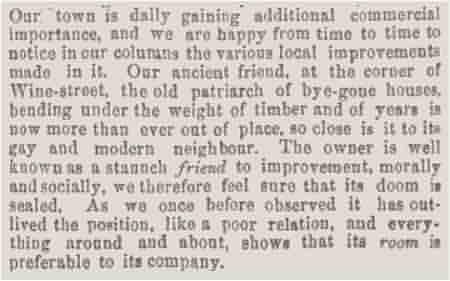
The Western Flying Post, in its issue of 4 December 1860, clearly did not have the emotional attachment to old buildings that many of us have today.
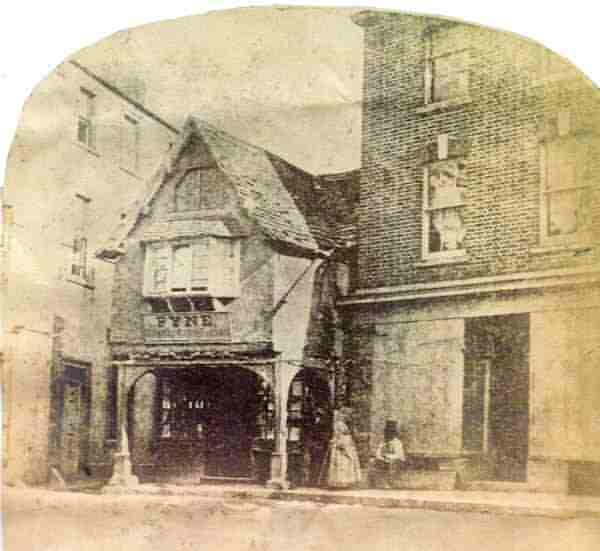
Courtesy of Mrs
M J Rogers
Under Bow, in the Borough on the corner of Grope Lane, photographed in 1861 by artist and photographer Frederick Treble. At far left is probably the first photograph of the Wine Street elevation of the newly-built Medical Hall, and at the right is an early photograph of the building that was part of Josiah Hannam's ironmongery and, later, William Maynard's Boro' Restaurant.
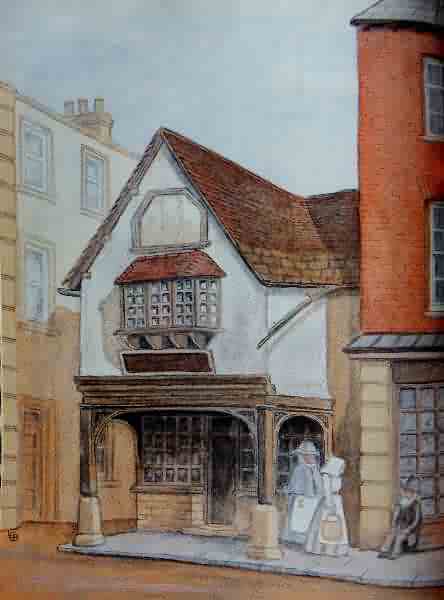
A painting of Under Bow, taken from the above photograph by Leslie Brooke.
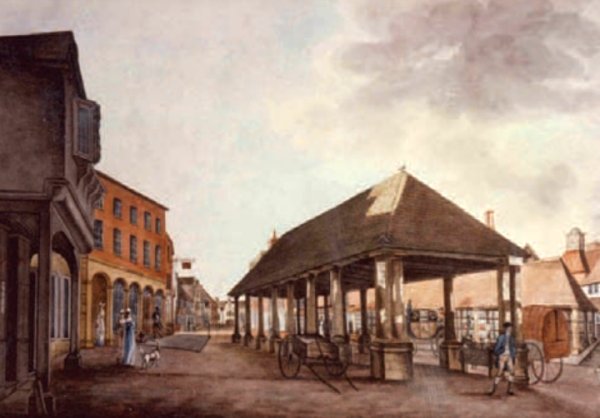
This painting
features in my
book 'Secret
Yeovil'
A painting made in 1810 of the Borough looking towards High Street which runs to the distance at left. The building at centre was the Market House, built in 1740, and behind it to the right was the butcher's Shambles, built in 1803.
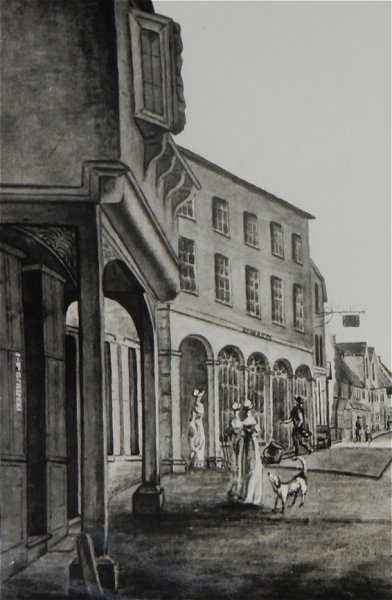
Part of the above 1810 painting of the Borough showing, at extreme left, the old house known as The Bow. The building at centre with the arched ground floor is the only building surviving in the Borough, today it is Superdrug.